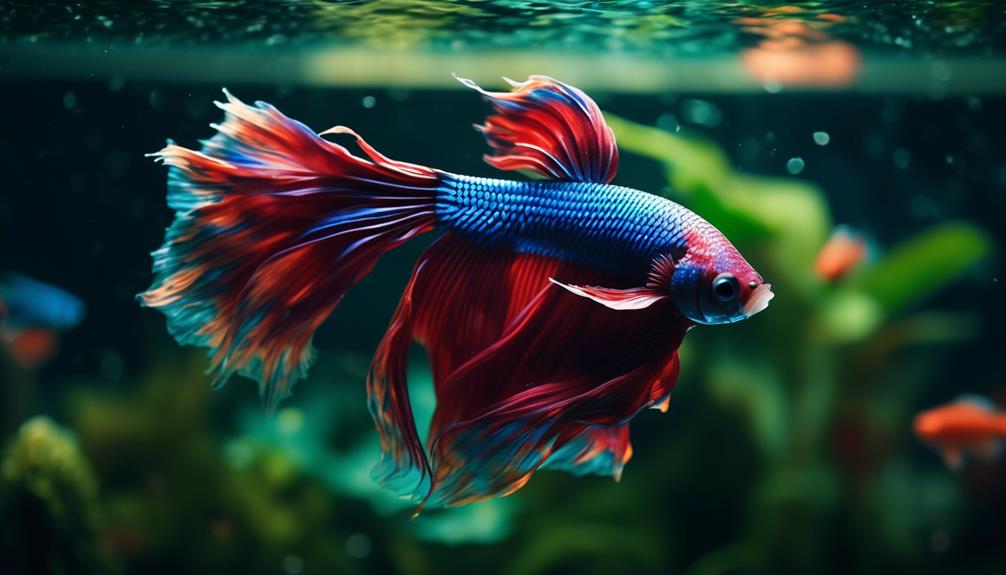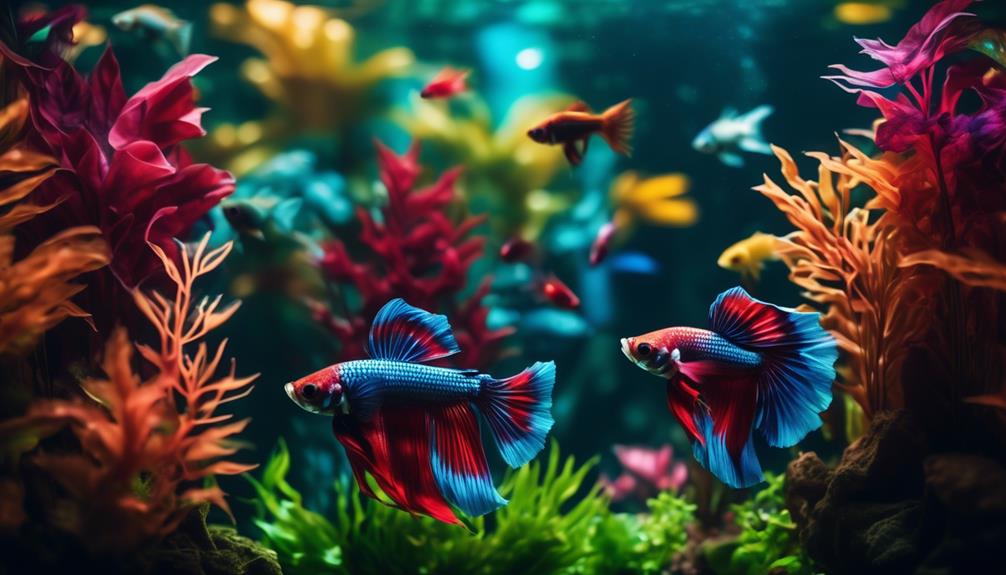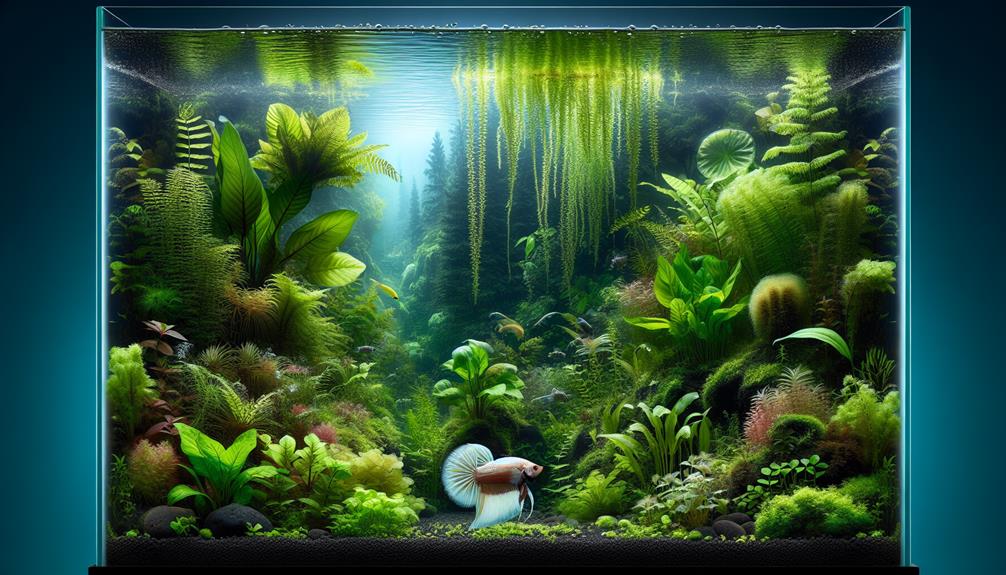Welcome to the ultimate betta fish plant guide, where we will explore a wide range of plant options to enhance your betta fish tank.
From easy-to-maintain plants to those suitable for nano tanks, we have carefully curated a selection that will not only add beauty to your aquarium but also provide numerous benefits for your bettas.
But that's not all – we will uncover plants specifically beneficial for breeding, natural filtration, stress reduction, and creating a natural habitat for your beloved bettas.
By incorporating these plants into your tank, you will improve water quality, provide hiding places, reduce algae growth, and create a visually pleasing environment.
So, without further ado, let's embark on this journey of discovering the ultimate betta fish plant guide and unlock the secrets to creating a thriving aquatic haven for your bettas.
Key Takeaways
- Betta fish plants offer various benefits such as minimal care, improved water quality, hiding places for bettas, and reduced algae growth.
- Low-light betta fish plants include Java Moss, Water Sprite, Hornwort, Java Fern, and Cryptocoryne, each with different growth rates.
- Floating betta fish plants provide water filtration, shade, privacy, and algae control benefits.
- Carpeting betta fish plants improve water quality, offer hiding places, and create a lush foreground, but require proper lighting, substrate, and CO2 supplementation.
Easy-to-Maintain Betta Fish Plants
Easy-to-Maintain Betta Fish Plants are a selection of plant species that require minimal care and attention, making them ideal for betta fish owners who are looking for hassle-free aquatic plants to enhance their aquarium.
These plants offer numerous benefits, such as enhancing water quality, providing hiding places for bettas, reducing algae growth, improving overall aquarium aesthetics, and creating a natural habitat for bettas.
When it comes to caring for low light betta fish plants, there are a few key considerations. Firstly, it is important to choose plant species that are suitable for low light conditions, such as Java Fern and Cryptocoryne.
Additionally, providing adequate nutrients through liquid fertilizers or root tabs can help promote healthy growth. Regularly trimming and removing any dead or decaying leaves will also ensure the plants remain in optimal condition.
Low-Light Betta Fish Plants
When it comes to selecting aquatic plants for low-light conditions in betta fish tanks, certain species such as Java Fern and Cryptocoryne are highly recommended. These plants thrive in low-light environments and offer numerous benefits for betta fish. Low-light betta fish plants provide a natural habitat for bettas, enhance water quality, reduce algae growth, and improve overall aquarium aesthetics. They also serve as hiding places for bettas, reducing their stress levels and creating a sense of security. Here are the best low-light betta fish plant options:
| Plant Name | Scientific Name | Growth Rate |
|---|---|---|
| Java Moss | Taxiphyllum barbieri | Fast |
| Water Sprite | Ceratopteris thalictroides | Moderate |
| Hornwort | Ceratophyllum demersum | Fast |
| Java Fern | Microsorum pteropus | Slow |
| Cryptocoryne | Cryptocoryne spp. | Slow |
These plants are not only easy to care for but also provide a beautiful and natural environment for your betta fish.
Floating Betta Fish Plants

Floating betta fish plants are an excellent addition to your aquarium as they provide numerous benefits for your betta fish while adding beauty and natural aesthetics to the tank. Here are three key benefits of using floating betta fish plants:
- Water Filtration: Floating plants such as duckweed, water lettuce, and salvinia help improve water quality by absorbing excess nutrients and reducing nitrate levels. This natural filtration system can help maintain a healthy and balanced environment for your betta fish.
- Shade and Privacy: Floating plants create shade and cover, providing your betta fish with hiding places and reducing stress. They also help to mimic the natural habitat of bettas, providing them with a sense of security.
- Algae Control: Floating plants can help control algae growth by blocking out excess light and competing for nutrients. This reduces the likelihood of algae blooms and keeps your aquarium clean and clear.
To properly care for floating betta fish plants, ensure they receive adequate lighting and nutrition. Regularly remove any excess or decaying plant matter to maintain water quality. Additionally, monitor the growth of floating plants to prevent them from covering the entire surface of the water and blocking out light for other aquarium inhabitants.
Carpeting Betta Fish Plants
Carpeting betta fish plants are a popular choice among aquarium enthusiasts due to their ability to create a lush and vibrant foreground in the tank. These plants not only enhance the aesthetic appeal of the aquarium but also provide numerous benefits.
One of the main advantages of carpeting betta fish plants is their ability to improve water quality by absorbing excess nutrients, thereby reducing the growth of harmful algae. Additionally, these plants offer hiding places for bettas, which helps to alleviate stress and create a more natural habitat for them.
To create a lush carpet in a betta fish tank, it is important to choose the right plant species such as Dwarf Hairgrass, Monte Carlo, Staurogyne Repens, Glossostigma Elatinoides, or Hemianthus Callitrichoides. Proper lighting, substrate, and CO2 supplementation are also essential for their healthy growth.
Betta Fish Plants With Colorful Leaves

Betta fish plants with colorful leaves add a vibrant and visually stunning element to the aquarium, enhancing the overall aesthetic appeal and creating a captivating environment for these beautiful fish.
Here are the top 5 colorful betta fish plants for beginners:
- Alternanthera Reineckii: This plant has striking red and pink leaves that create a dramatic contrast in the aquarium.
- Ludwigia Repens: With its deep red and orange foliage, this plant adds a splash of color to any tank.
- Rotala Rotundifolia: This plant features bright green and red leaves that create a visually appealing display.
- Red Tiger Lotus: Known for its large, red and purple leaves, this plant adds a bold and exotic touch to the aquarium.
- Cryptocoryne Wendtii: This plant comes in various colors, including green, bronze, and red, making it a versatile choice for adding color to the tank.
To care for betta fish plants with colorful leaves, provide them with adequate lighting, nutrient-rich substrate, and regular fertilization. Additionally, ensure proper water parameters and maintain good water quality to promote their growth and overall health.
Frequently Asked Questions
Can Betta Fish Be Kept in a Tank With Plants?
Betta fish can be kept in a tank with plants, as they provide numerous benefits. Plants enhance water quality, offer hiding places, reduce algae growth, improve aesthetics, and create a natural habitat for bettas.
How Often Should I Water the Betta Fish Plants?
The watering frequency for betta fish plants depends on the specific plant species and environmental conditions. Generally, it is recommended to water them when the top layer of soil feels dry to the touch. Regular care and monitoring are essential to ensure optimal health and growth.
Are There Any Specific Requirements for Lighting When It Comes to Betta Fish Plants?
The lighting requirements for betta fish plants vary depending on the specific species. Generally, low to moderate light is sufficient for most plants. Some recommended plants for betta fish tanks include Java Fern, Anubias, and Cryptocoryne.
Can Betta Fish Plants Be Grown in a Small Container or Jar?
Growing betta fish plants in a small container or jar is possible, but it requires careful attention to water quality, lighting, and proper plant selection. Betta fish plants provide numerous benefits for aquariums, including enhancing aesthetics and creating a natural habitat for bettas.
How Do Betta Fish Plants Contribute to the Overall Health and Well-Being of the Fish?
Betta fish plants contribute to the overall health and well-being of the fish by enhancing water quality, providing hiding places, reducing algae growth, improving aquarium aesthetics, and creating a natural habitat. These benefits make them essential for the care of bettas.
Conclusion
In conclusion, the world of betta fish plants offers a wide range of options to enhance your aquarium and provide numerous benefits for your bettas. By incorporating easy-to-maintain plants, low-light plants, floating plants, carpeting plants, and plants with colorful leaves, you can improve water quality, provide hiding places, reduce algae growth, and create a visually pleasing environment for your bettas.
Whether you are a beginner or an experienced betta fish enthusiast, the ultimate betta fish plant guide equips you with the knowledge to create a thriving and aesthetically pleasing habitat for your beloved fish.

